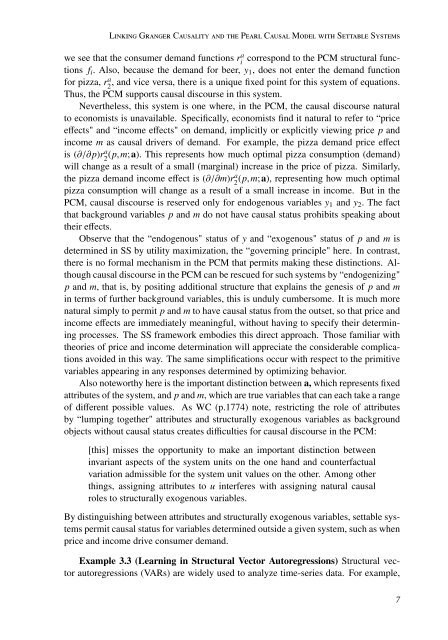Causality in Time Series - ClopiNet
Causality in Time Series - ClopiNet
Causality in Time Series - ClopiNet
Create successful ePaper yourself
Turn your PDF publications into a flip-book with our unique Google optimized e-Paper software.
L<strong>in</strong>k<strong>in</strong>g Granger <strong>Causality</strong> and the Pearl Causal Model with Settable Systemswe see that the consumer demand functions ri a correspond to the PCM structural functionsf i . Also, because the demand for beer, y 1 , does not enter the demand functionfor pizza, r2 a , and vice versa, there is a unique fixed po<strong>in</strong>t for this system of equations.Thus, the PCM supports causal discourse <strong>in</strong> this system.Nevertheless, this system is one where, <strong>in</strong> the PCM, the causal discourse naturalto economists is unavailable. Specifically, economists f<strong>in</strong>d it natural to refer to “priceeffects" and “<strong>in</strong>come effects" on demand, implicitly or explicitly view<strong>in</strong>g price p and<strong>in</strong>come m as causal drivers of demand. For example, the pizza demand price effectis (∂/∂p)r2 a (p,m;a). This represents how much optimal pizza consumption (demand)will change as a result of a small (marg<strong>in</strong>al) <strong>in</strong>crease <strong>in</strong> the price of pizza. Similarly,the pizza demand <strong>in</strong>come effect is (∂/∂m)r2 a (p,m;a), represent<strong>in</strong>g how much optimalpizza consumption will change as a result of a small <strong>in</strong>crease <strong>in</strong> <strong>in</strong>come. But <strong>in</strong> thePCM, causal discourse is reserved only for endogenous variables y 1 and y 2 . The factthat background variables p and m do not have causal status prohibits speak<strong>in</strong>g abouttheir effects.Observe that the “endogenous" status of y and “exogenous" status of p and m isdeterm<strong>in</strong>ed <strong>in</strong> SS by utility maximization, the “govern<strong>in</strong>g pr<strong>in</strong>ciple" here. In contrast,there is no formal mechanism <strong>in</strong> the PCM that permits mak<strong>in</strong>g these dist<strong>in</strong>ctions. Althoughcausal discourse <strong>in</strong> the PCM can be rescued for such systems by “endogeniz<strong>in</strong>g"p and m, that is, by posit<strong>in</strong>g additional structure that expla<strong>in</strong>s the genesis of p and m<strong>in</strong> terms of further background variables, this is unduly cumbersome. It is much morenatural simply to permit p and m to have causal status from the outset, so that price and<strong>in</strong>come effects are immediately mean<strong>in</strong>gful, without hav<strong>in</strong>g to specify their determ<strong>in</strong><strong>in</strong>gprocesses. The SS framework embodies this direct approach. Those familiar withtheories of price and <strong>in</strong>come determ<strong>in</strong>ation will appreciate the considerable complicationsavoided <strong>in</strong> this way. The same simplifications occur with respect to the primitivevariables appear<strong>in</strong>g <strong>in</strong> any responses determ<strong>in</strong>ed by optimiz<strong>in</strong>g behavior.Also noteworthy here is the important dist<strong>in</strong>ction between a, which represents fixedattributes of the system, and p and m, which are true variables that can each take a rangeof different possible values. As WC (p.1774) note, restrict<strong>in</strong>g the role of attributesby “lump<strong>in</strong>g together" attributes and structurally exogenous variables as backgroundobjects without causal status creates difficulties for causal discourse <strong>in</strong> the PCM:[this] misses the opportunity to make an important dist<strong>in</strong>ction between<strong>in</strong>variant aspects of the system units on the one hand and counterfactualvariation admissible for the system unit values on the other. Among otherth<strong>in</strong>gs, assign<strong>in</strong>g attributes to u <strong>in</strong>terferes with assign<strong>in</strong>g natural causalroles to structurally exogenous variables.By dist<strong>in</strong>guish<strong>in</strong>g between attributes and structurally exogenous variables, settable systemspermit causal status for variables determ<strong>in</strong>ed outside a given system, such as whenprice and <strong>in</strong>come drive consumer demand.Example 3.3 (Learn<strong>in</strong>g <strong>in</strong> Structural Vector Autoregressions) Structural vectorautoregressions (VARs) are widely used to analyze time-series data. For example,7





